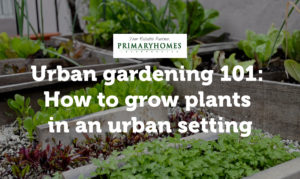
It is an age-old cry of the city dweller: “I’d love to grow my own food, but I don’t have the space!”
While city dwellers like contemporary living, Primary homes offer a lifestyle thats fit for modern living that’s perfect for urban gardening.
What is urban gardening? At heart, it is a garden that has to confirm to a small or specific space. Beyond that, it can take all kinds of form, depending on what your site calls for.
Urban gardening often means growing on rooftops, balconies, alleyways, sidewalks or whatever little space the garden has available.
The only limitation is our imagination and willingness to experiment. Remember: Every good gardener has killed many plants along the learning curve.
If you are new to growing vegetables in containers, or have had limited success, here are a few tips to help you succeed all from an expert at gardening — Gigi Uy, owner of God’s Grace Farm.
No Space, No Problem:
Not everyone has a backyard, roof or balcony. Uy, said that in order to overcome this issue, one should opt container gardening or “Vertical Gardening”.
While decorative pots can be lovely, they don’t improve the quality of your plants and can be expensive.
Instead, you can use a large bucket from a garden store, which is a low-cost and effective option.
Or upcycle containers not in use, such as crates, old toys or paint cans. That way, you’re not only saving from additional expenses, you’re saving the environment as well.
Plant Selection:
There are vegetable, flower and herb varieties that are easy to grow in urban spaces.
They can easily be bought at hardware, grocery stores, or from your nearest Agrivet stores.
Uy said that when planning your garden, think about what to plant – shallow-rooted veggies, such as herbs, lettuce and radishes typically do better in confined spaces.
Plant Right:
Potting your plants takes a few simple steps.
Put some gravel in the bottom of your container to help with drainage and fill with potting mix.
Potting mix helps retain moisture and resist compaction which is good for your seeds.
Also, leave 1 inch at the top for watering. Tamp the soil after the plants are in place and water gently.
Water Wise:
Hand water every morning.
Once the plants are large and summer is hot, they will probably need watering in the evening, too.
A little afternoon shade can keep them from drying out too quickly.
Drain Gain:
Whatever container you choose for your garden, remember drainage holes are essential.
Without proper drainage, soil can become waterlogged and plants may die.
The holes need to be large enough to allow excess water to drain out.
Plants need food too:
Like humans, plants also need nutrition in order to grow. Water and sunlight may not just be enough for them.
According to Uy, feed your vegetation with vitamins, minerals, fertilize with compost and add more soil every two months.
Uy who has been long devoted to gardening for 5 years, notes that one advantage of container gardens at home is that they allow you to easily move them in and out of the sun.
If your plants seem to dry out in one window area, you can try different areas to adjust to what works best.
She also said that one common mistake urban gardeners make is not making sure that the soil is in good quality.
While those made with pesticide promises great results, they are loaded with chemicals.
“Go for organic soil and grow well from the beginning,” she said.
Gardening not only results in food or flowers, it is a great way to relieve stress.
“Have fun and get in touch with nature,” she added.
Just because you live in a subdivision or an apartment does not mean you cant experience the joy or eating what you grow.
At Primary homes, enjoy the luxury of living at your own space that is ideal for cultivating your own urban garden. Your reliable partner, Primary Homes provides options for you to stay while starting your own urban vegetation without any intrusion.
ADVT